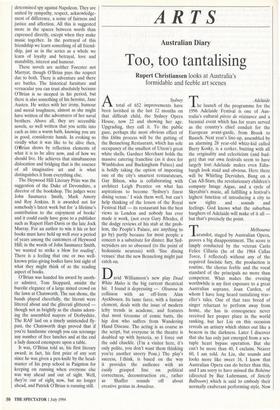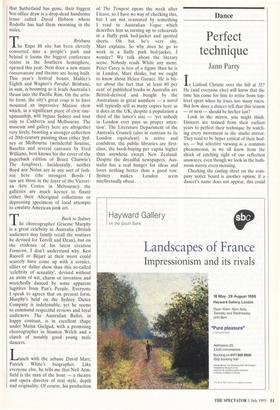ARTS
Australian Diary
Too, too tantalising
Rupert Christiansen looks at Australia's formidable and feeble art scenes
Sydney
totaltotal of 652 improvements have been lavished in the last 12 months on that difficult child, the Sydney Opera House, now 22 and showing her age. Upgrading, they call it. To the public gaze, perhaps the most obvious effect of this £60m process will be the gutting of the Bennelong Restaurant, which has sole occupancy of the smallest of Utzon's great white shells. Gardner Merchant holds the massive catering franchise (as it does for Wimbledon and Buckingham Palace) and is boldly taking the option of importing one of the city's smartest restaurateurs, Gay Bilson, who is collaborating with architect Leigh Prentice on what has aspirations to become 'Sydney's finest dining venue.' I wish them well, but can't help thinking of the lesson of the Royal Festival Hall — its restaurant has the best views in London and nobody has ever made it work, (not even Gary Rhodes, if the dodgy reviews of his stab at the prob- lem, the People's Palace, are anything to go by) partly because for most people a concert is a substitute for dinner. But Syd- neysiders are so obsessed (to the point of hedonistic neurosis) with 'fine dining venues' that the new Bennelong might just catch on.
David Williamson's new play Dead White Males is the big current theatrical hit. I found it depressing — Oleanna in collision with an off-form Alan Ayckbourn. Its lame farce, with a fantasy element, deals with the issue of modern lefty trends in academe, and features that most tiresome of comic butts, the hip don who suffers from Wandering Hand Disease. The acting is as coarse as the script, but everyone in the theatre is doubled up with hysteria, so I force out the odd chuckle. (I'm a visitor here, it's only polite, you don't want them thinking you're another sneery Pom.) The play's success, I think, is based on the way it provides the audience with an easily grasped line on political correctness, deconstruction etc., rather as Shaffer sounds off about creative genius in Amadeus. Adelaide The launch of the programme for the 1996 Adelaide Festival is one of Aus- tralia's cultural pieces de resistance and a biennial event which has for years served as the country's chief conduit for the European avant-garde, from Brook to Bausch. Next year's line-up, assembled by an alarming 28 year-old whizz-kid called Barry Kosky, is a corker, buzzing with all the originality and eclecticism (and bud- get) that our own festivals seem to have largely lost: Adelaide makes even Edin- burgh look staid and obvious. Here there will be Whirling Dervishes, Bang on a Can All-Stars, the revolutionary children's company Image Aigue, and a cycle of Skyrabin's music, all fulfilling a festival's highest function of introducing a city to new sights and sounds and feelings. God knows what the suburban burghers of Adelaide will make of it all but that's precisely the point.
TMelbourne urandot, staged by Australian Opera, proves a big disappointment. The score is limply conducted by the veteran Carlo Felice Cillario (he of the 1964 Callas Tosca, I reflected) without any of the required fascistic fury, the production is routine, the chorus feeble and the vocal standard of the principals no more than competent. What makes the evening worthwhile is my first exposure to a great Australian soprano, Joan Carden, of whom I have long heard tantalizing trav- eller's tales. One of that rare breed of singer reluctant to perform away from home, she has in consequence never received her proper place in the world ranking, but her Liu on this occasion reveals an artistry which shines out like a beacon in the darkness. Later I discover that she has only just emerged from a sex- tuple heart bypass operation. But she can't be more than 40, I exclaim. Nearer 60, I am, told. As Liu, she sounds and looks more like sweet 16. I know that Australian Opera can do better than this, and I am sorry to have missed the Boheme (directed by Baz Luhrmann, of Strictly Ballroom) which is said to embody their normally exuberant performing style. Now that Sutherland has gone, their biggest box-office draw is a drop-dead handsome tenor called David Hobson whose Rodolfo has had them swooning in the aisles.
Brisbane The Expo 88 site has been cleverly converted into a people's park and behind it looms the biggest conference centre in the Southern hemisphere, opened this year. Next door a new music conservatoire and theatre are being built. This year's festival boasts Mahler's Eighth and Wagner's Parsifal. Brisbane, in sum, is booming as it leads Australia's thrust into the Pacific Rim. On the artis- tic front, the city's great coup is to have mounted an impressive Matisse show which, in a significant piece of civic one- upmanship, will bypass Sydney and tour only to Canberra and Melbourne. The museum and gallery here are altogether very lively, boasting a stronger collection of 20th-century painting than either Syd- ney or Melbourne (wonderful Soutine, Baselitz and several canvases by Fred Williams, best known for the cover of the paperback edition of Bruce Chatwin's The Songlines). Incidentally, neither Boyd nor Nolan are in any sort of fash- ion here (the strongest Boyds I saw are those in the foyer of the Victori- an Arts Centre in Mebourne): the galleries are much keener to flaunt either their Aboriginal collections or depressing specimens of local attempts to emulate American junk art.
Back to Sydney The choreographer Graeme Murphy is a great celebrity in Australia (British audiences may faintly recall the routines he devised for Torvill and Dean), but on the evidence of his latest creation Fornicon, I don't understand why. Ken Russell or Br jart at their worst could scarcely have come up with a cornier, sillier or duller show than this so-called `celebrity of sexuality', devised without an atom of wit, charm or invention and wretchedly danced by some apparent fugitives from Pan's People. Everyone I speak to agrees that on present form, Murphy's hold on the Sydney Dance Company is indefensible, yet he seems to command respectful reviews and loyal audiences. The Australian Ballet, in happy contrast, is in excellent shape under Maina Gielgud, with a promising choreographer in Stanton Welch and a clutch of notably good young male dancers.
Lunch with the urbane David Marr, Patrick White's biographer. Like everyone else, he tells me that Neil Arm- field is the man of the hour — a theatre and opera director of real style, depth and originality. Of course, his production of The Tempest opens the week after I leave, so I have no way of checking this, but I am not reassured by something I read in Australian Vogue which describes him as turning up to rehearsals in a fluffy pink bed-jacket and spotted shorts. Oh but he's very shy, Marr explains. So why does he go to work in a fluffy pink bed-jacket, I wonder? We talk about the literary scene. Nobody reads White any more. Peter Carey is less of a figure than he is in London, Marr thinks, but we ought to know about Helen Garner. He is bit- ter about the fact that 'at least 80 per cent' of published books in Australia are British-derived and bought by the Australians in great numbers — a novel will typically sell as many copies here as it does in the UK, despite a population a third of the latter's size — 'yet nobody in London ever pays us proper atten- tion'. The Literature Department of the Australia Council (also in contrast to its London equivalent) is active and confident, the public libraries are first- class, the book-buying per capita higher than anywhere except New Zealand. Despite the dreadful newspapers, Aus- tralia has a real hunger for ideas and loves nothing better than a good row: Sydney makes London seem intellectually obese.



































































 Previous page
Previous page